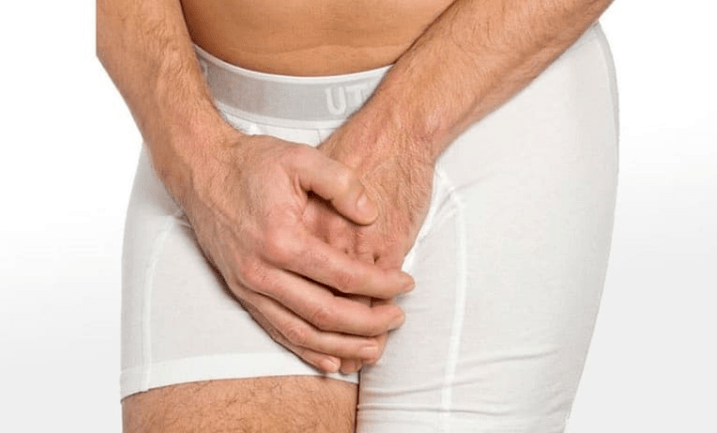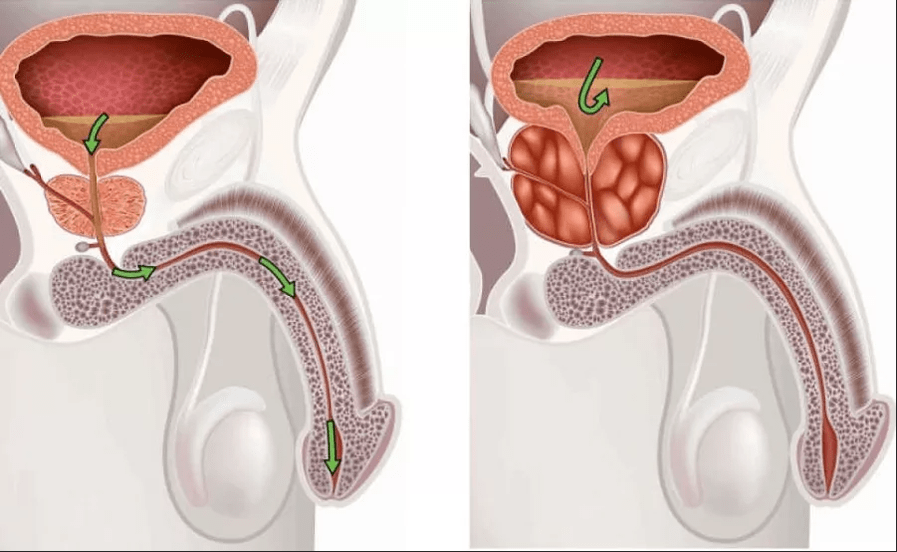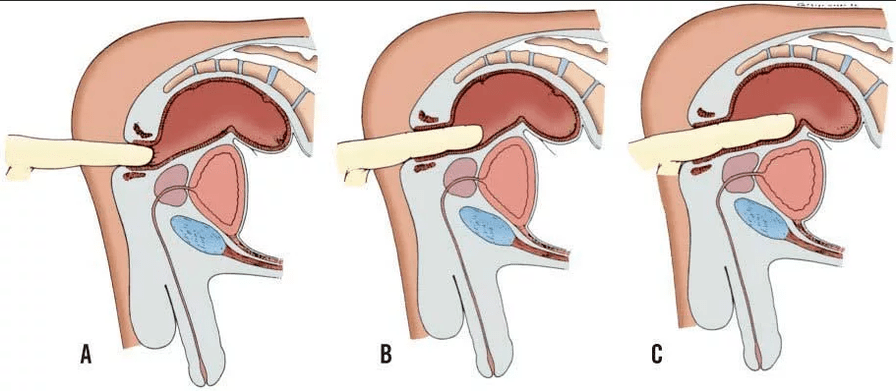Prostatitis is an inflammation of the person's prostate gland.The prostate is just below the bladder and the size of a chestnut.It surrounds the first part of the urethra and extends to the floor of the so -called pelvis, which consists of muscles.

The prostate produces secretion, which includes PSA and sperm.PSA makes ejaculation more liquid.Spermine is important for sperm mobility.
Prostatitis is mainly associated with severe pain in the perineum and the anal region.Moreover, symptoms such as urination frequency, pain during urination and pain during spilling occur during prostate inflammation.
The prostate is affected relatively often by inflammation.The probability of prostate infection increases with age.Studies show that most cases aged 40 to 50 years.
Prostatitis syndrome
At the same time, an extended meaning of the term prostate appeared in medicine.With the so -called prostate syndrome, some complaints are summarized in the human pelvic area, which usually has an unknown reason.The term "prostatitis syndrome" summarizes various clinical paintings:
- Acute bacterial prostatitis
- Chronic bacterial prostatitis
- Inflammatory and non -inflammatory syndrome of chronic pelvic pain
- Asymptomatic prostatitis
Acute and chronic bacterial prostatitis
Acute prostatitis is caused by bacteria.Bacteria either pass through the blood to the prostate, or spread by bacterial infection of the bladder or urethra in the prostate.Acute prostatitis is usually a serious general condition with severe pain during urination, fever and chills.
Chronic prostatitis can develop from acute: if for more than three months there is inflammation of the prostate gland and recurrent microbes in the urine, the so -called prostate or ejaculated prostate, then this is chronic inflammation.
Bacterial prostatitis.This is less lightning speed than acute prostate.Although chronic inflammation of the prostate gland causes pain during urination and, perhaps, a feeling of pressure in the perineum, but complaints are usually not as pronounced as in acute prostatitis.
Chronic pelvic pain syndrome (abacterial prostatitis)
In most cases, prostate infections, bacteria cannot be detected in the urine, prostate or ejaculate as the cause of the disease.Prostatitis promotion remains unclear.Doctors call it chronic pelvic pain.
However, in such cases, leukocytes can often be detected as an expression of inflammation in the prostate gland.To distinguish this, no other form of the disease has been discovered in which neither bacteria nor leukocytes are detected.Chronic pelvic pelvic syndrome is the most common form of prostatitis.

Asymptomatic prostatitis
In rare cases, asymptomatic prostatitis occurs.With this form of prostatitis, although there are signs of inflammation, but there are no pain or other symptoms.Asymptomatic prostatitis is usually detected by accident, for example, as part of an infertility study.
Prostatitis: Symptoms
Prostate inflammation can cause various symptoms of prostatitis.Although the symptoms of acute prostatitis can be very serious and cause a strong feeling of wrongdoing, with chronic prostatitis they are usually somewhat weaker.
Acute prostatitis: symptoms
Acute prostatitis is often an acute disease in which patients suffer from fever and chills.Uring causes burning pain, and the flow of urine is significantly reduced due to the edema of the prostate gland.Since victims can only distinguish a small amount of urine, they have a constant urination frequency and often have to go to the toilet.Other prostatitis symptoms include bladder, pelvic pain and back pain.Pain can also occur during or after spilling.
Chronic Prostatitis: Symptoms
Prostatitis with a chronic course usually causes less serious symptoms than acute prostate inflammation.Symptoms such as fever and chills are usually completely absent.Symptoms, such as feeling pressure in the perineum or lower abdomen, darkening ejacula due to blood in semen or blood in the urine is typical of chronic prostate inflammation. Symptoms of chronic bacterial and chronic abacterial prostatitis do not change.
Complications of prostate
The most common complication is prostate abscess.The abscess of the prostate gland is a purulent inflammation of inflammation, which usually should be opened and empty with a cut.
As a further complication of prostate inflammation, inflammation can be applied to nearby structures, such as the testicular or testicular supplement.There are also suspicions that chronic prostatitis is associated with the development of prostate cancer.
Prostatitis: Causes and Risk Factors
Bacterial Prostatitis: Causes
Only ten percent of prostate cases are caused by a prostate bacterium.Bacteria can enter the prostate through the blood or by neighboring organs, such as bladder or urethra, where they can lead to an inflammatory reaction.
Escherichia coli bacterium, which is mainly found in the human intestine, is the most common cause of prostatitis.Klebsiella, enterococci or mycobacteria can also cause prostate.Bacterial prostatitis can also be caused by sexually transmitted diseases such as chlamydial or trichomonas infections, as well as gonorrhea.
In chronic prostate, bacteria in the prostate gland avoided the non -clarified way of protecting the human immune system.This allows germs to constantly colonize the prostate.Antibiotics are relatively weak in the tissues of the prostate gland, which can be another cause of bacterial survival in the prostate gland.
Chronic pelvic pelvic syndrome: Causes
The exact causes of chronic pelvic pain syndrome have not yet been fully studied.Scientists have named many theories, each of which sounds reliable, but they are not all clearly proven.In some cases, the genetic material of previously unknown microorganisms was found in the pelvis.Therefore, the cause of pelvic pain syndrome can be microorganisms that still cannot be cultivated in the laboratory and, therefore, are not detected.
Another possible cause of chronic pelvic pain are bladder disorders.Due to damaged drainage, the volume of the bladder increases, which thus suppresses the prostate.This pressure ultimately damages the tissue of the prostate gland, causing inflammation.
However, in many cases, the cause of chronic pelvic pain cannot be clearly demonstrated.Then doctors talk about idiopathic prostatitis.
Anatomical causes
In rare cases, the prostate is caused by narrowing of the urinary tract.If the urinary tract is narrowed, the urine accumulates and, if it enters the prostate, it can also cause inflammation.This narrowing can be caused by so -called prostate tumors or prostate stones.
Mental
Recently, more and more psychological causes of prostatitis have been discussed.In particular, with non -inflammatory syndrome of chronic pelvic pain, a mental stimulus is likely.The correct mechanisms are still unknown.
Risk factors for prostatitis development
Some men are particularly at risk of developing prostate infection.These include, for example, men with immune system violations or suppressed by the immune system.Moreover, major diseases, such as diabetes mellitus, can contribute to the development of prostatitis: an increased blood sugar level in patients with diabetes often leads to an increased level of sugar in the urine.The abundant sugar content in the urine can provide bacteria with good growth conditions, facilitating the development of urinary tract infections.
Another risk factor in prostate development is bladder cooperation.Inserting a catheter through the urethra through the urethra can cause minor disruption of the urethra and damage to the prostate gland.In addition, as in any foreign body, the bacteria can be placed in the bladder and form the so -called biophilm.As a result, bacteria can rise along the urethra in the bladder as well as lead to prostate infection.
Prostatitis: examinations and diagnostics
A general doctor may get a medical history, but if there is a suspicion of the prostate, it will direct you to a urologist.This performs a physical examination.In case of prostate suspicion, this is usually the study of the so -called digital rectum.However, this study does not provide clear evidence of prostate inflammation, but only confirms suspicion.To detect bacterial prostatitis, a laboratory examination can be done
Rectum
Since the prostate gland is directly limited to the rectum, it can be palpated in the rectum.This study of digital rectum is performed on outpatient basis and without anesthesia, usually painless.The patient is required to extend with bent legs.Using a lubricant, the doctor then slowly inserts the finger into the anus and scans the prostate organs and glued.It examines size and sensitivity to pain in the prostate gland.

Laboratory
To identify potential pathogens in most cases, urine analysis is performed.The standard method is the so -called four glasses sample.Here Ertur, Mittelstrahlur, prostatexprimat and urine are tested after prostate massage.As prostatexprimat called, doctors call prostate secretion.This is achieved by a doctor with slight pressure on the prostate, for example, in palpation.Ejaculation can also be tested for pathogenic microorganisms and signs of inflammation.
Further research
Ultrasound scanning of the rectum can be used to determine exactly where the inflammation is and how much it spreads.An important purpose of the study is the exclusion of other diseases with similar symptoms.
To exclude that the existing violation of urine drainage is caused by the narrowing of the urethra, the urinary flow is measured.The normal urine flow is from 15 to 50 milliliters per second, while the urine flow is ten milliliters per second or less, there is a high probability of urethra obstruction.
Prostatitis: Treatment

Drug therapy
Acute bacterial prostatitis is treated with antibiotics.In mild cases, the dose of antibiotic is sufficient for about ten days.In chronic prostatitis, the medicine should be taken for a longer period of time.Depending on the pathogenic microorganisms, the active substances of luxury, ciprofloxacin, azithromycin, erythromycin or doxycycline are appropriate.Even if the symptoms are already decreasing, antibiotics in any case should continue in accordance with the appointment of a physician.
Also, asymptomatic prostatitis is treated with antibiotics.
If there is chronic abacterial prostatitis, antibacterial therapy is usually ineffective.With chronic pelvic pain syndrome, despite the lack of evidence of the presence of the pathogen, a study is performed using antibiotics, as it can sometimes be achieved.However, with non -inflammatory syndrome of chronic pelvic pain, antibiotics therapy is not recommended.
Other therapeutic approaches to chronic abacterial prostatitis are so-called 5α-reductase inhibitors, such as fineride or dutasteride, pentosan polysulfate and herbal medicines, such as quercetin or dust extract.If the improvement is not achieved, medication therapy will be supplemented with physiotherapy.Here are recommended physiotherapy exercises, pelvic floor muscles or regular prostate massage.
Moreover, symptomatic therapy can help relieve acute symptoms of prostate infection.Anesthetic drugs can be prescribed for severe pain.Also, heat pillows and heat pads on the back or lower abdomen help to relax the muscles.This often relieves pain with prostate inflammation.
relapse
The frequency of prostatitis restitution is generally very high.About 23 percent of victims undergo the second episode of the disease after an illness, 14 percent suffer from three, and 20 percent - even four or more cases of the disease.To reduce the risk of relapse, avoid wearing wet clothing during or after prostate, hypothermia or bubble use, such as black tea or coffee.This reduces the risk of cystitis and, therefore, prostatitis.However, you cannot reliably prevent bacterial prostatitis using these methods.
The prostatitis prognosis depends, on the one hand, on the cause of inflammation and on the other, how fast the correct therapy begins.
In acute bacterial prostatitis, which is treated as soon as possible with antibiotic therapy, the prognosis is usually good.Taking antibiotics, pathogens die, which usually prevents transition to chronic prostatitis.
About 60 percent of all patients with acute prostate no longer have symptoms in six months, and about 20 percent develop chronic prostatitis.Treatment and prognosis are more difficult here.In many cases, periodic episodes of the disease arise that may accompany those who suffer for many years.
Chronic prostatitis usually requires great patience from victims.Very often a long course can be a serious psychological load.
Patients who have suffered should seek professional help, as the mental health situation has a major impact on prostate prediction.






















